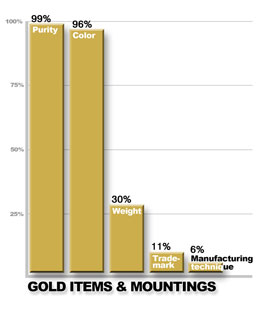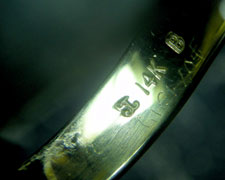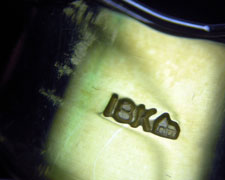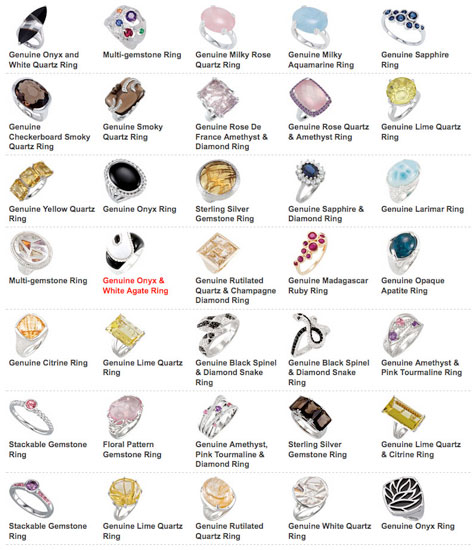 Jewelry Hallmark – A Well-Kept Secret
Jewelry Hallmark – A Well-Kept Secret
One would hardly buy a car, a computer, a cell phone-or probably even a breakfast cereal-without knowing the maker of it. Yet jewelry shoppers can spend thousands of dollars on a purchase and not know the maker of the jewelry. Why is that? And why does it matter?
"Manufacturer" is one of rarest things to find on a jewelry appraisal. Big names like Tiffany will be noted, but most makers will not. A survey of appraisals received by insurance companies found that only 11% of them had information on the manufacturer.
The maker's mark
Hallmarks on jewelry began in England in 1300. The law required that any silver or gold item be tested for purity and then stamped to indicate that it met legal standards. In 1363 a maker's mark was introduced. Today, many European countries agree on a system that requires jewelry be stamped with the metal's purity, the maker, and the place and year that the item was made. Other marks may be added.
![]()
In this British example, AB is the mark of the sponsor (who submitted the piece to the assay office for purity testing), the Yorkshire rose is the mark of the Sheffield Assay Office (where the item was tested), the lion indicates silver, 925 indicates purity (the metal is 925 per 1000 parts silver), the lowercase a is the date (a stands for the year 2000), and the last bit is the "Millennium mark," a special mark available only for the years 1999 and 2000.
U.S. marks are not so elaborate. The Metal Stamping Act requires that any jewelry sold as gold be stamped with karatage, and that any item that is stamped with the karatage must also bear the manufacturer's registered trademark. The purpose of this law is that if underkarating occurs, the trademark helps trace the offending item to its source.
The manufacturer's mark usually appears as a symbol, rather than a name, to save space on the small jewelry item. The symbols can be quite mysterious. Even if you could magnify an item to see the mark, it would be meaningless to most of us. We need to know the name of the manufacturer.
There are so many trademarks that even a professional appraiser could not recognize all of them, so information on the jewelry's maker should be stated on the seller's sales receipt and/or appraisal. Ideally, the manufacturer's style number should also be given.
Why the cover-up?
Many people think their jeweler made each necklace and ring on display. They regard their own jewelry as unique. Actually, most "jewelers" are jewelry retailers, with limited training in gemology and little experience in jewelry design.
The vast majority of jewelry sold today is manufactured in quantity and sold through manufacturers' representatives, trade shows, and catalogs. Jewelers can order entire finished pieces; or they can order jewelry blanks, semi-mounts, and stones separately, then put together combinations likely to please their customers.
Concealing the manufacturer, not mentioning it on the appraisal, is to the retailer's advantage. It preserves the aura of uniqueness, and it prevents comparison shopping. A consumer cannot go from one jeweler to another and say, "I want this ring from manufacturer ABC, style #123 (as listed in the catalog), with a diamond of such-and-such quality-what do you charge?"
Insurers, please note:This also means that comparison shopping is difficult for adjusters pricing a replacement. It would be infinitely easier to simply give a jeweler or replacement company all the data on a piece of jewelry and get a price. And you would know that the replacement exactly matched the original. This is routinely done with watches, as manufacturer and style number are usually known.
To move in the direction of full disclosure on all jewelry, the JISO 78/79 appraisal, the insurance industry's standard, specifically requests manufacturer and style number. Having this information takes the hassle out of claim settlements and guarantees that the insured will be made whole.
FOR AGENTS & UNDERWRITERS
You will seldom encounter one-of-a-kind items. The vast majority of jewelry is not unique and does not depend on rarity for its value.
Having the manufacturer and style number on the appraisal will make claim settlement much easier.
Ask for a JISO 78/79 appraisal or, if the appraiser is not a Certified Insurance Appraiser™, for JISO 805 or 806. All of these specifically request manufacturer and style number.
FOR ADJUSTERS
You will seldom encounter one-of-a-kind items.
Check for manufacturer and style number, as this information will greatly facilitate pricing a replacement and will guarantee a like-kind replacement.
Never assume a lost piece cannot be duplicated or a damaged piece cannot be repaired, even if the jewelry looks complicated or the appraisal description is inadequate.
If a large settlement is involved, it may be worthwhile to consult a jewelry insurance expert before settling the claim.
©2000-2025, JCRS Inland Marine Solutions, Inc. All Rights Reserved. www.jcrs.com






